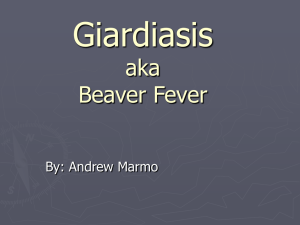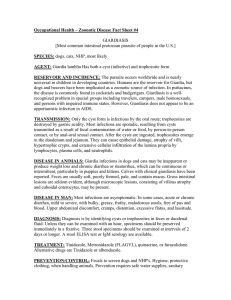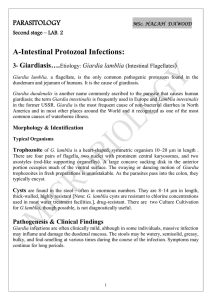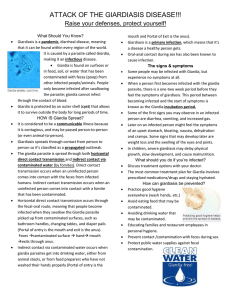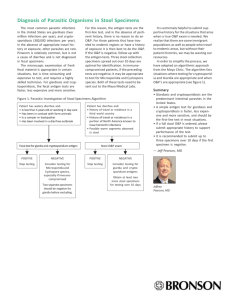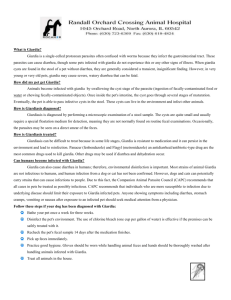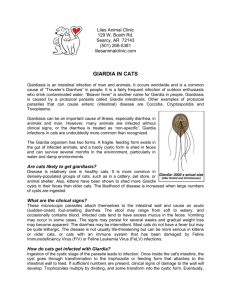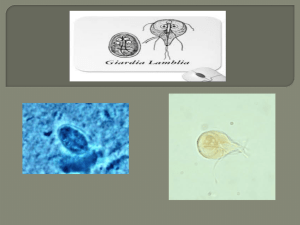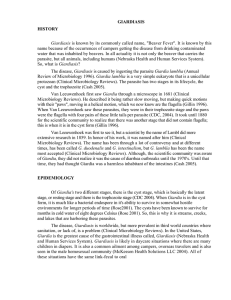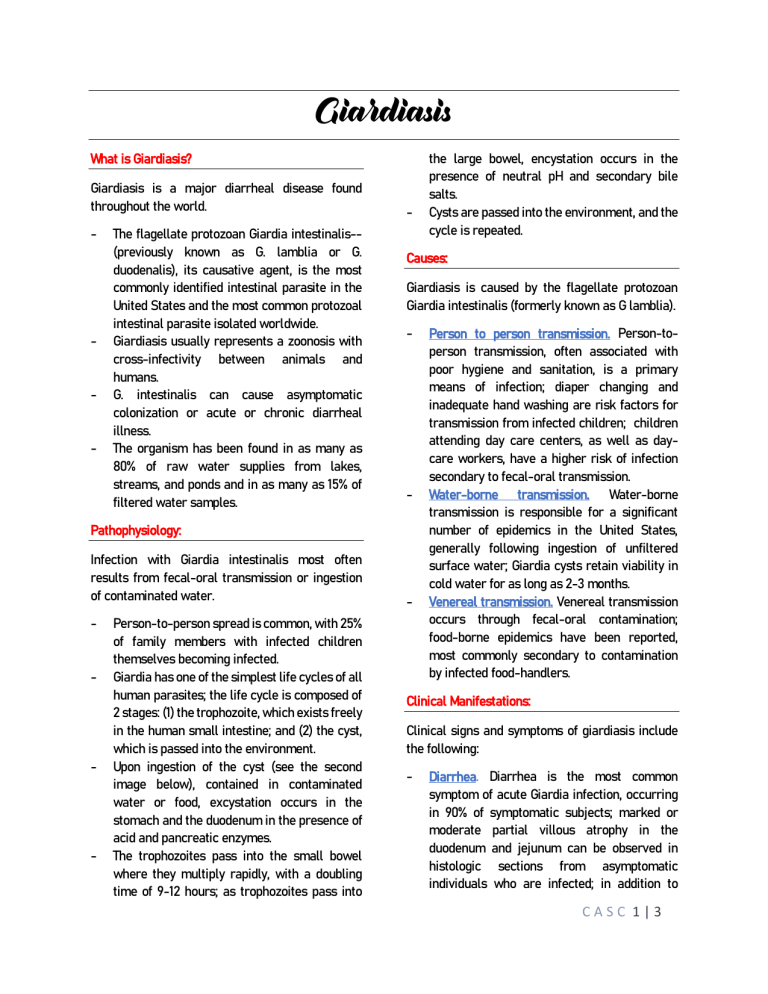
Giardiasis What is Giardiasis? Giardiasis is a major diarrheal disease found throughout the world. - - - - The flagellate protozoan Giardia intestinalis-(previously known as G. lamblia or G. duodenalis), its causative agent, is the most commonly identified intestinal parasite in the United States and the most common protozoal intestinal parasite isolated worldwide. Giardiasis usually represents a zoonosis with cross-infectivity between animals and humans. G. intestinalis can cause asymptomatic colonization or acute or chronic diarrheal illness. The organism has been found in as many as 80% of raw water supplies from lakes, streams, and ponds and in as many as 15% of filtered water samples. - Causes: Giardiasis is caused by the flagellate protozoan Giardia intestinalis (formerly known as G lamblia). - - Pathophysiology: Infection with Giardia intestinalis most often results from fecal-oral transmission or ingestion of contaminated water. - - - - Person-to-person spread is common, with 25% of family members with infected children themselves becoming infected. Giardia has one of the simplest life cycles of all human parasites; the life cycle is composed of 2 stages: (1) the trophozoite, which exists freely in the human small intestine; and (2) the cyst, which is passed into the environment. Upon ingestion of the cyst (see the second image below), contained in contaminated water or food, excystation occurs in the stomach and the duodenum in the presence of acid and pancreatic enzymes. The trophozoites pass into the small bowel where they multiply rapidly, with a doubling time of 9-12 hours; as trophozoites pass into the large bowel, encystation occurs in the presence of neutral pH and secondary bile salts. Cysts are passed into the environment, and the cycle is repeated. - Person to person transmission. Person-toperson transmission, often associated with poor hygiene and sanitation, is a primary means of infection; diaper changing and inadequate hand washing are risk factors for transmission from infected children; children attending day care centers, as well as daycare workers, have a higher risk of infection secondary to fecal-oral transmission. Water-borne transmission. Water-borne transmission is responsible for a significant number of epidemics in the United States, generally following ingestion of unfiltered surface water; Giardia cysts retain viability in cold water for as long as 2-3 months. Venereal transmission. Venereal transmission occurs through fecal-oral contamination; food-borne epidemics have been reported, most commonly secondary to contamination by infected food-handlers. Clinical Manifestations: Clinical signs and symptoms of giardiasis include the following: - Diarrhea. Diarrhea is the most common symptom of acute Giardia infection, occurring in 90% of symptomatic subjects; marked or moderate partial villous atrophy in the duodenum and jejunum can be observed in histologic sections from asymptomatic individuals who are infected; in addition to CASC 1|3 - - - disrupting the mucosal epithelium, effects in the intestinal lumen may contribute to malabsorption and the production of diarrhea. Malaise, weakness. Malaise or weakness occurs due to loss of electrolytes with diarrhea. Abdominal distention. Abdominal cramping, bloating, and flatulence occurs in 70-75% of symptomatic patients. Malodorous, greasy stools. Stools become malodorous, mushy, and greasy. Anorexia and weight loss. Anorexia, fatigue, malaise, and weight loss are common; weight loss occurs in more than 50% of patients and averages 10 pounds. Assessment and Diagnostic Findings: The traditional basis of diagnosis is the identification of Giardia intestinalis trophozoites or cysts in the stool of infected patients via a stool ova and parasite (O&P) examination. - - - Stool examination. Stool examination for trophozoites or cysts is the traditional method for diagnosing giardiasis; at least 3 stools taken at 2-day intervals should be examined for ova and parasites; trophozoites may be found in fresh, watery stools but disintegrate rapidly. Stool antigen detection. Several tests to detect Giardia antigen in the stool are commercially available; these utilize either an immunofluorescent antibody (IFA) assay or a capture enzyme-linked immunosorbent assay (ELISA) against cyst or trophozoite antigens; these tests have a sensitivity of 85-98% and a specificity of 90-100%. String test. The string test (Entero-test) consists of a gelatin capsule containing a nylon string with a weight attached to it; the patient tapes one end of the string to his or her cheek and swallows the capsule; after the gelatin dissolves in the stomach, the weight carries the string into the duodenum; the mucus from the string is examined for trophozoites in an iodine or saline wet mount or after fixation and staining. Medical Management: Standard treatment for giardiasis consists of antibiotic therapy. - - - Fluid therapy. Appropriate fluid and electrolyte management is critical, particularly in patients with large-volume diarrheal losses. Diet. No special diet is required; a significant portion of patients have symptoms of lactose intolerance (cramping, bloating, diarrhea), and maintenance on a lactose-free diet for several months may be helpful. Activity. Activity restrictions are not indicated; however, infected subjects who are at risk of spreading the infection should be isolated and treated Pharmacologic Management: Antibiotic therapy is standard in the treatment of giardiasis. Antibiotics. The 2 major classes of drugs that have proven benefit in the treatment of giardiasis are nitroimidazole derivatives and acridine dyes; although most experts recommend metronidazole and tinidazole as the drugs of choice because the brief treatment periods encourage good patient adherence, treatment failures occur in as many as 20% of cases, probably because of resistance; therefore, treatment with a second-line drug (eg, mepacrine) may be necessary. Nursing Management: Nursing Assessment: - - History. The nature of the overall clinical manifestations in affected patients is influenced by numerous factors, including the parasite load, virulence of the isolate, and the host immune response. Physical exam. Physical examination does not contribute to the diagnosis of giardiasis; weight loss may be evident, but no known CASC 2|3 unique physical findings are attributable to giardiasis. Nursing Diagnosis: - Diarrhea related to enteric infections. Fluid volume deficit related to GI losses. Impaired sense of comfort: pain related to smooth muscle spasm. Hyperthermia related to decrease in circulation secondary to dehydration. Nursing Interventions: - - - Restore Fluid & Electrolyte balance. Weigh patient daily and note decreased weight; record number and consistency of stools per day; if desired, use a fecal incontinence collector for accurate measurement of output; monitor and record intake and output; note oliguria and dark, concentrated urine; discuss the importance of fluid replacement during diarrheal episodes. Reduce pain or discomfort. Assess the extent and characteristics of pain; give a warm compress on the abdomen; teach the client and caregivers about methods to distract from the pain and set a position that can reduce the pain. Improve hyperthermia. Provide tepid sponge baths; administer antipyretics as prescribed. CASC 3|3
